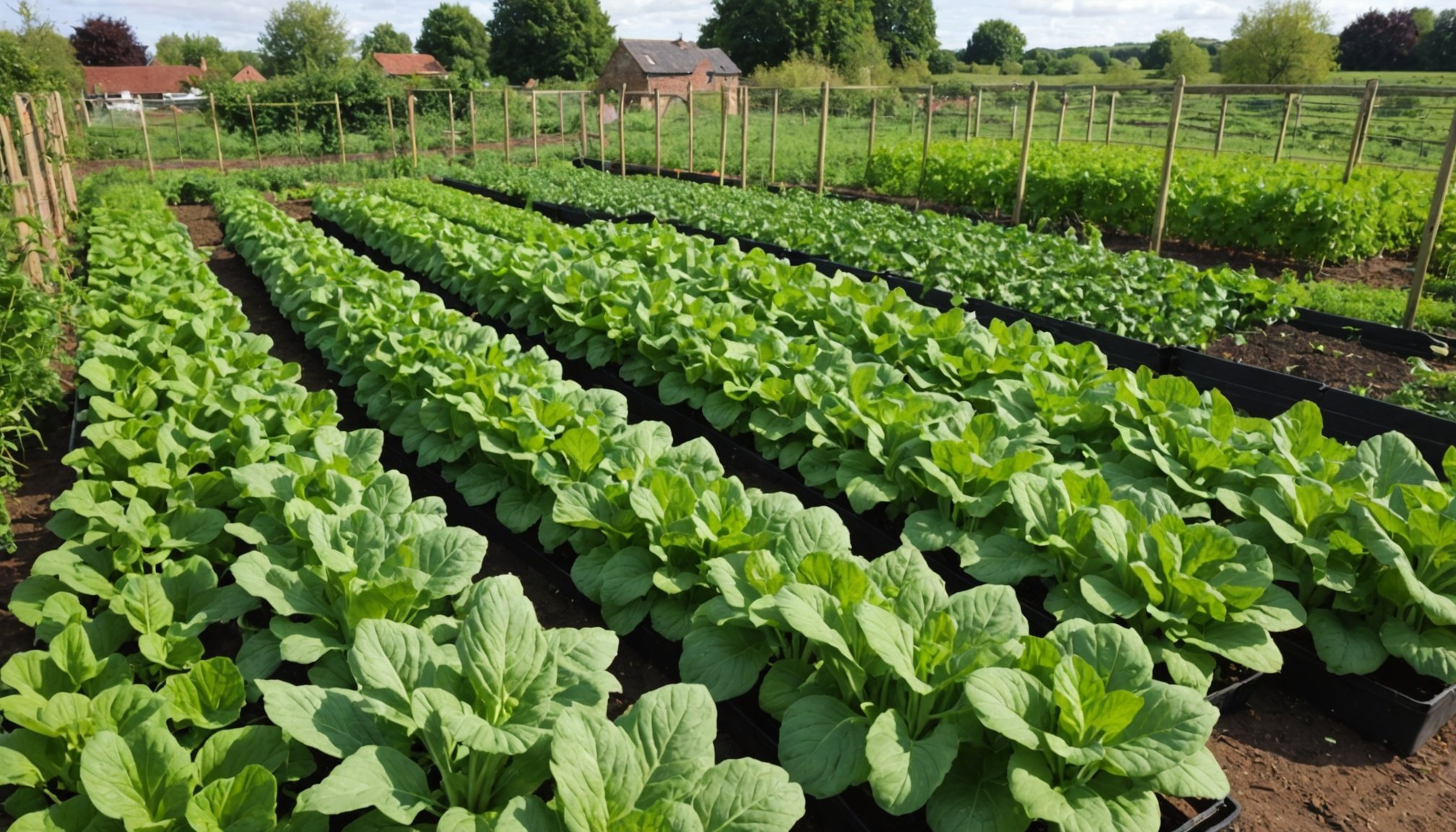Companion planting is revolutionising how UK allotment gardeners maximise their vegetable yields. By pairing plants that work in harmony, growers can naturally deter pests, enhance nutrient absorption, and improve overall plant health. Discover how strategic combinations, such as tomatoes and basil or carrots and onions, can lead to thriving harvests. Uncover the science behind these partnerships and practical tips to apply them in your garden for success. Your vegetable patch could be just one companion away from flourishing!
Overview of Companion Planting
Companion planting is a strategic gardening technique that involves growing different plants together to enhance growth, deter pests, and improve vegetable yields. This method, deeply rooted in organic gardening, leverages the natural relationships between plants to create a more balanced and productive garden ecosystem.
Also read : Unlocking the Secrets to Thriving Winter Gardening in the UK”s Chilly Climate
Historically, companion planting has been practiced for centuries, with indigenous cultures often utilizing this approach to maximize crop productivity. A well-known example is the "Three Sisters" technique, where maize, beans, and squash are planted together. Each plant contributes to the growth of the others: maize provides a structure for beans to climb, beans fix nitrogen in the soil, and squash spreads along the ground, suppressing weeds.
The principles of companion planting focus on the mutual benefits plants can offer each other. For instance, some plants can repel pests that might otherwise attack their neighbors, while others can enhance soil fertility or provide shade. This approach is particularly significant in sustainable gardening as it reduces the need for chemical fertilizers and pesticides, promoting a healthier environment.
Additional reading : Ultimate Guide: How to Successfully Overwinter Exotic Plants Indoors in the UK
By encouraging biodiversity, companion planting not only boosts vegetable yields but also supports the health of the entire garden ecosystem. Embracing these techniques can lead to a more resilient and thriving garden, aligning with the goals of organic gardening.
Beneficial Plant Pairings for UK Vegetable Gardens
Companion planting is a thoughtful practice that requires understanding vegetable compatibility. In the UK, certain plant pairings can significantly enhance garden productivity. For instance, pairing tomatoes and basil is popular; basil can repel pests like aphids and improve tomato flavour. Similarly, carrots and onions work well together, as onions deter carrot flies, enhancing the overall health of both crops.
UK-Specific Pairings
The UK climate allows for unique combinations. For example, cabbage and dill thrive together; dill attracts beneficial insects that prey on cabbage pests. Another successful pairing is radishes with cucumbers. Radishes can act as a trap crop for cucumber beetles, protecting the cucumbers from damage.
Choosing Compatible Plants
When planning your garden, consider each plant's needs. Vegetable compatibility involves assessing factors like sunlight, soil type, and water requirements. For a diverse vegetable crop, choose plants that complement each other’s growth habits. For example, tall plants like corn can provide shade for lettuce, which prefers cooler temperatures.
Incorporating these strategies into your garden planning can lead to a more productive and harmonious garden environment. By selecting compatible plants, you not only boost yields but also create a balanced ecosystem that supports sustainable gardening practices.
Implementing Companion Planting in Allotments
Companion planting can be a game-changer for allotment gardening, offering practical ways to enhance productivity and sustainability. To effectively incorporate this method, consider these planting strategies.
Begin by assessing your allotment's current layout. Identify areas where companion plants can be introduced without disrupting existing crops. For example, interplanting herbs like basil or dill among vegetables can deter pests and attract beneficial insects. This integration not only boosts plant health but also optimises space usage.
Planning and layout considerations are crucial. Arrange taller plants such as corn or sunflowers to the north of your allotment to prevent shading smaller, sun-loving plants. This strategic positioning ensures all plants receive adequate sunlight. Additionally, group plants with similar water and soil needs to streamline care and maintenance.
Timing is another key factor. Seasonal timing for planting companions is essential to maximise benefits. For instance, planting fast-growing crops like radishes early in the season can protect slower-growing plants from pests. As the season progresses, replace harvested crops with new companions that suit the changing climate.
By thoughtfully integrating companion planting into your allotment, you can create a more resilient and productive garden environment, aligning with sustainable gardening practices.
Soil Health and Companion Planting
Understanding the role of companion planting in enhancing soil health is crucial for any gardener. By carefully selecting plant pairings, you can naturally improve soil quality, which is vital for robust plant growth. Certain plants, like legumes, are known for their ability to fix nitrogen, enriching the soil and benefiting neighbouring plants.
To support these plant pairings, consider using organic amendments. These can include compost, aged manure, and green manure crops like clover. Such amendments not only provide essential nutrients but also improve soil structure and water retention. Regularly incorporating organic materials can lead to a thriving garden ecosystem.
Testing soil quality is an essential step in managing nutrient management effectively. Conducting a soil test helps you understand the current nutrient levels and pH balance, guiding you in making informed decisions about which amendments to add. This ensures optimal growth conditions for your plants.
Improving soil quality involves a combination of good practices. Rotate crops to prevent nutrient depletion, and use mulch to protect soil from erosion and retain moisture. By focusing on soil health through companion planting and organic amendments, you create a sustainable environment that supports healthy plant development and maximizes garden productivity.
Pest Management Through Companion Planting
Companion planting serves as an effective strategy for pest control by utilising natural deterrents. This gardening technique reduces the need for chemical pesticides, promoting a healthier garden environment. By strategically placing certain plants together, gardeners can repel harmful insects and protect their crops.
Several plant allies are known to act as natural deterrents against pests. For example, marigolds are famous for repelling nematodes and aphids, making them ideal companions for vegetables like tomatoes and peppers. Similarly, nasturtiums can deter squash bugs and whiteflies, providing a protective barrier for cucumbers and squash. Another powerful ally is garlic, which can ward off Japanese beetles and aphids, benefiting a wide variety of plants.
Integrated pest management strategies can be enhanced through companion planting by combining plant pairings with other sustainable practices. For instance, introducing beneficial insects such as ladybirds and lacewings can further aid in controlling pest populations. Additionally, maintaining plant diversity within the garden can disrupt the lifecycle of pests, making it harder for them to establish.
By embracing these gardening techniques, you can create a robust and resilient garden ecosystem. This approach not only safeguards your plants but also contributes to a more sustainable and environmentally friendly gardening practice.
Challenges and Considerations in Companion Planting
Companion planting, while beneficial, presents its own set of gardening challenges. Understanding these can help gardeners avoid common pitfalls and make the most of their efforts. One frequent issue is the mismatch of plant needs, such as differing water or sunlight requirements, which can lead to poor growth or plant stress.
To address these companion planting pitfalls, careful planning is essential. Begin by researching each plant's specific needs and compatibility with others in your garden. This step helps prevent competition for resources and ensures a harmonious environment. Additionally, consider the growth habits of plants; for instance, avoid pairing tall, sun-loving plants with those that require shade.
Troubleshooting plant pairing issues often involves trial and error. Monitor your garden closely for signs of distress, such as yellowing leaves or stunted growth. Adjustments may be necessary, such as repositioning plants or altering watering schedules.
Regularly monitoring plant health is crucial. Keep an eye on growth patterns and pest activity, making adjustments as needed. This proactive approach allows for timely interventions, ensuring a thriving garden. By staying vigilant and responsive, gardeners can overcome challenges and fully benefit from the advantages of companion planting.
Case Studies and Testimonials from Local Gardeners
Exploring gardener experiences provides valuable insights into the practical applications of companion planting. Across the UK, many allotment owners have successfully implemented these techniques, leading to enhanced yields and healthier gardens.
Successful Companion Planting Examples
In one UK allotment, a gardener reported substantial improvements by pairing tomatoes with marigolds, noting a significant reduction in pest activity. This example illustrates how strategic plant combinations can naturally deter pests, reducing reliance on chemical solutions.
Another gardener shared their success story with the Three Sisters method, a traditional technique involving maize, beans, and squash. This approach not only maximised space but also created a symbiotic environment where each plant thrived.
Community Insights and Best Practices
Local gardeners often share community insights, offering lessons learned from their experiences. One common piece of advice is to start small, experimenting with a few plant pairings before expanding. This allows gardeners to observe interactions and make informed adjustments.
Testimonials frequently highlight the importance of soil preparation and regular monitoring. By understanding the unique needs of each plant, gardeners can create more effective pairings. Engaging with the gardening community provides invaluable support and knowledge, fostering a culture of shared learning and sustainable practices.











